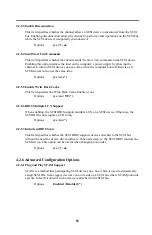
50
4.2.2 SCSI Parity Checking
SCSI parity checking is a procedure used by the channel to verify the accuracy of data transfer on
the SCSI bus. By default, parity checking is enabled on all channels. Disable parity checking for a
channel if any SCSI device on the channel does not support SCSI parity.
Options
Enabled (*) / Disabled
4.2.3 Host Adapter SCSI Termination
This field configures the SCSI termination of the LEAGCY channel. Note that the terminator of the
LVD/SE channel is always enabled.
Options
Description
High ON/Low Auto
Enable High terminators and Low terminator automatic
detect.
High OFF/Low OFF
Disable both High and Low terminators
4.2.4 Boot Device Options
Press <Enter> to bring up Boot Device menu.
4.2.4.1 Boot SCSI ID
This field specifies the SCSI ID of the device from which you wish to boot.
Options
0 (*) / 1 / 2 / 3 / 4 / 5 / 6 / 7 / 8 / 9 / 10 / 11 / 12 / 13 / 14 / 15
4.2.4.2 Boot LUN Number
This field specifies which LUN to boot from on the boot device if the boot device has
multiple LUNs and Multiple LUN Support field is enable.
Options
0 (*) / 1 / 2 / 3 / 4 / 5 / 6 / 7
4.2.5 SCSI Device Configuration
Press <Enter> to bring up SCSI Device Configuration menu.
4.2.5.1 Initiate Wide Negotiation
This field specifies whether the channel attempts 16-bit instead of 8-bit data transfer.
Options
yes (*) / no
4.2.5.2 Sync Transfer Rate (MB/Sec)
This field specifies the maximum synchronous data transfer rate that the channel supports.
Options
80.0 (*) / 53.4 / 40.0 / 32.0 / 26.8 / 20.0 / 16.0 / 13.4 / 10.0/ASYN




































